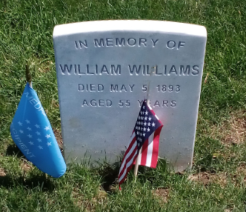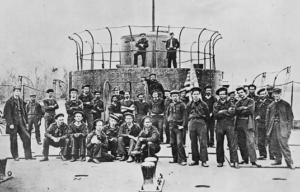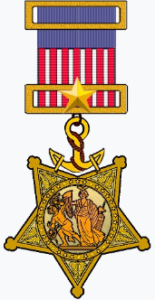Title: Navy Seaman, Civil War; Medal of Honor
Birthdate: 1838
Death Date: May 5, 1893
Plot Location: Naval 2, Row 23, Grave 13

The Pennsylvania Department of Military Affairs has records for more than a dozen men named William Williams, making documentation of this sailor’s life somewhat difficult. His birth was in County Louth on the eastern shore of Ireland in either 1838 or 1840.
When he first enlisted in the Navy as a Landsman in March of 1863 Bill said he was a shoemaker. He was assigned to a just-built ironclad, the USS Lehigh, that was sent on blockade duty  to Newport News, Virginia. This is a photo of the crew on the James River, so one of these men must be Bill.
to Newport News, Virginia. This is a photo of the crew on the James River, so one of these men must be Bill.
By September the Lehigh was part of the South Atlantic Blockading Squadron. She took 29 hits from Fort Moultrie in one day, and engaged almost daily in attacking Fort Sumter in October. On November 16 the Lehigh ran aground on a sand bar in Charleston Harbor and was under heavy fire. Two crew members attempted to attach a tow line to the USS Nahant, another ironclad that was nearby. Each time they tried, the line failed.
 Just before the crew was about to abandon ship, Bill and two others volunteered to try again. Rowing a small boat from one ship to the other and knowing the chances of being shot, they attached the line and the Lehigh was towed to safety.
Just before the crew was about to abandon ship, Bill and two others volunteered to try again. Rowing a small boat from one ship to the other and knowing the chances of being shot, they attached the line and the Lehigh was towed to safety.
For their bravery, all five men were awarded the Medal of Honor on April 14, 1864. This is a rendering of the Naval version, used until 1912, featuring a rope and anchor.
At one point Bill was assigned to the USS St. Louis. It may have been while she was part of the blockade in 1864-65. Or it may have been after the war, since Bill reenlisted for another tour of duty in 1866. He may have been assigned to the St. Louis after it was decommissioned and used as a receiving ship (to train new recruits) in Philadelphia. By the time he was discharged he had been promoted to Seaman.
The paper trail about the next two decades of Bill’s life is lacking. One listing in the 1880 census has someone with his name as a ship rigger in Philadelphia. His last years were spent at the Naval Home on Grays Ferry Road. That’s where he suffered from tuberculosis and died in 1893.
This seaman was one of about 400 Medal of Honor recipients considered “lost to history” by the Medal of Honor Historical Society of the United States. Many of the military grave markers here had become illegible, so a transcription survey was begun several years ago by the Friends of Mount Moriah Cemetery. Almost 700 identities had been recovered by 2016, and Bill’s was among them.
A group of volunteers from Villanova University transcribed his original illegible grave marker. Their findings were submitted, then confirmed by MOHHSUS, then approved by a historian from the Department of Veterans’ Affairs. Thanks to our volunteers, seven of these formerly “Lost to History” honorees have had their grave markers replaced by the VA.

Support the Friends of Mount Moriah
Help us in our mission to restore and maintain the beautiful Mount Moriah Cemetery by donating to our cause or volunteering at one of our clean-up events.

